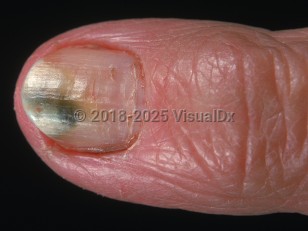The "green nail syndrome," or chloronychia, is characterized by the clinical triad of:
- Green discoloration of the nail plate
- Paronychia
- Distolateral onycholysis
Pseudomonas species are gram-negative, aerobic coccobacilli that are found in soil, water, plants, and animals (including humans).
Pseudomonas aeruginosa is an opportunistic pathogen that can infect pulmonary, kidney, and urinary tract systems. It may infect soft tissue, skin, and nails in both immunocompetent and immunocompromised patients. The bacteria can colonize and infect any area of the nail plate (distal, lateral, proximal) where there is
onycholysis. Exposure to a moist environment or frequent use of soaps / detergents, trauma,
onychotillomania (compulsive manipulation or pulling out of the nails),
chronic paronychia, and associated nail diseases such as
psoriasis may promote infection by
Pseudomonas. The subsequent pigmentation varies both with the species involved and with the composition of the pigments produced. The greenish hue varies from light green to deep, dark green.
Pseudomonas species produce a number of diffusible pigments such as pyocyanin (dark green) and fluorescein (yellow-green). Both are soluble in water; the former is also soluble in chloroform.
The main complaint of patients is the green discoloration of the nails. Patients must avoid excessive exposure to moist environments, or they will have a high rate of recolonization even after treatment.
Green nails are more common in hairdressers, dishwashers, food handlers, and health care workers.
Green nail syndrome is rare in children but can be seen in those who are immunosuppressed.



 Patient Information for
Patient Information for 
